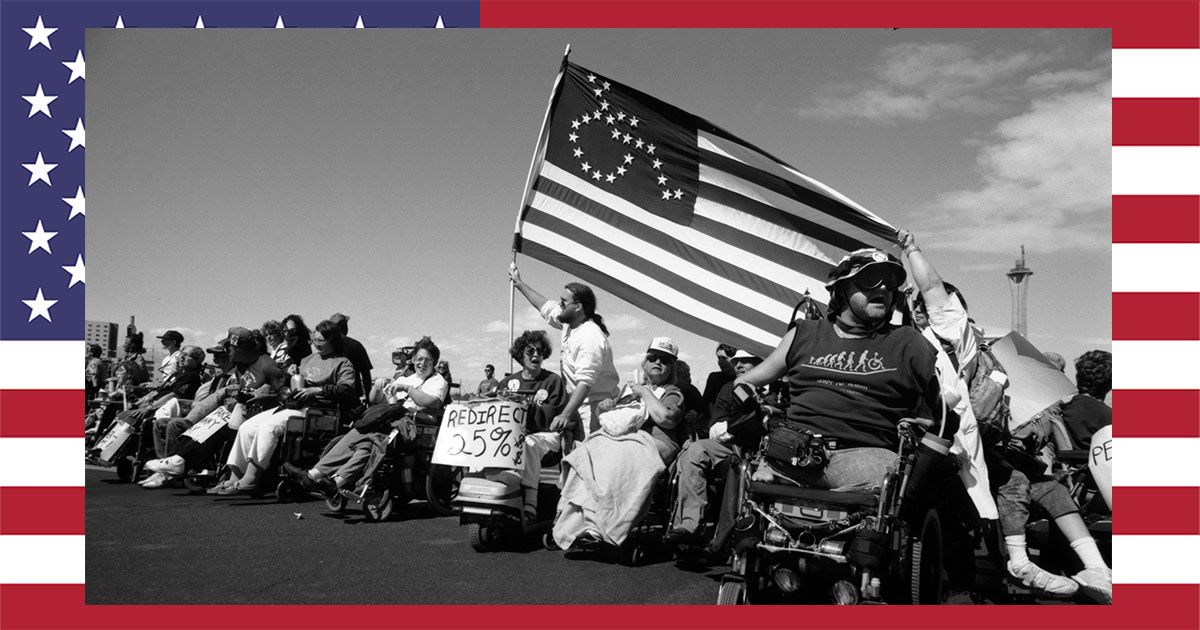
As people across the United States gather to celebrate Independence Day we ask ourselves, “What does true independence look like?” With no disrespect to our country or those who have defended it, the concept of independence is quite different for people with disabilities.
The Independent Living philosophy is based on the belief that persons with disabilities have the same basic human rights as persons without disabilities to participate in and contribute to community life. Independent Living can look different to different people; it doesn’t necessarily mean doing everything independently. As Disability Rights advocate Judy Heumann put it, “Independent Living is not doing things by yourself; it is being in control of how things are done.”
The Civil Rights Act of 1964 did not include people with disabilities (PWD). It wasn’t until 1990 that PWD got the Americans with Disabilities Act (ADA). The ADA is a civil rights law that prohibits discrimination against PWD in all areas of public life including places that are open to the general public. That was a good start, however we are still fighting for independence and equality. Barriers to independence for PWD exist in many forms: attitudinal, physical, and programmatic; and they exist on both a personal and systemic level.
Attitudinal discrimination against PWD is most commonly associated with individual’s attitudes – assumptions that PWD can’t or don’t want to work, or that we can’t make decisions for ourselves, or manage our legal and financial affairs. It’s true, these attitudes exist in individuals throughout our society, however, it doesn’t stop at the individual level; unfortunately, it also exists at a systemic level when policies are being made or when programming and infrastructure are being developed. Very often if there is not a person with a disability involved in the planning stages, the needs of PWD are overlooked.
Often when people think about barriers for PWD, they think of physical barriers for people in wheelchairs. Whether it’s a lack of accessible parking, stairs with no ramp or elevator, or a lack of curb-cuts . . . physical barriers are common and they make it impossible for a person using a mobility device to navigate with the same independence that others do. Have you ever heard a restaurant employee say to someone in a wheelchair, “Oh, it’s okay, a couple of us can carry you up those stairs”? This is not a solution, and it is clearly not what independence looks like.
Less obvious to many, are programmatic barriers. This often comes in the form of communication needs. How many times do you hear someone say, “I don’t need a microphone, I’ll speak loudly.”? Well for people who are hard of hearing that isn’t going to cut it! And for someone who is Deaf, not even the microphone will make them hear you; interpretation services will be needed. Offering a presentation with a lot of visual slides demonstrating your point without providing image descriptions is not effective communication for someone who is blind. Presenting information in an accessible format doesn’t mean the same thing to everyone. To address everyone’s needs, simply ask everyone in advance if they need an accommodation to participate.
Some neurodivergent people may not be able to participate in certain events or activities at all. People who have sensory sensitivities might experience severe headaches or seizures from bright or flashing lights, loud noise, or scented products. Some people are highly sensitive to being touched, being in a crowded space, or being in closed rooms. Being excluded due to inaccessible environments is not what independence looks like.
In recent years, many businesses have undertaken work to improve their environments through the lens of Diversity, Equity and Inclusion (DEI) which is raising awareness of the needs of people with marginalized identities. Let’s make sure disability is included in that lens.
So, what does independence look like for PWD? Perhaps our vision statement says it best: “Our vision is a community that values disability as human diversity, free of attitudinal barriers, where all people benefit with full access and inclusion.” Imagine a world where people with disabilities are not viewed as being any more “different” than someone with freckles, or someone who is left-handed. A world where spaces are designed to be used by all people regardless of disability. Equal access to our communities is not too much to expect; in fact, it should be demanded!
While signing the ADA into law, over three decades ago, President George H. W. Bush proclaimed, “. . . and now, may the shameful wall of exclusion finally come tumbling down!” Until PWD are granted true independence, this will never be our reality.
Ways you can DARE to Impact Change:
- Contact your local Center for Independent Living (CIL) to become involved in Disability Rights advocacy. Follow this link to find the CIL in your area.
- Join the National Council of Independent Living (NCIL) to stay informed of Disability Rights issues on a national level.
More Information on the Topic:
- Our fight for disability rights and why we’re not done yet (Tedx Talks YouTube video)
- Disability Pride: The High Expectations of a New Generation (article – read or listen)
- Crip Camp: A Disability Revolution(Netflix documentary film)
Note: This article is a publication of Disability Network Southwest Michigan and was written for our DARE to Impact Change publication which provides Disability Advocacy, Rights & Education. Follow this link for more info and to subscribe to our DARE to Impact Change e-publication.
